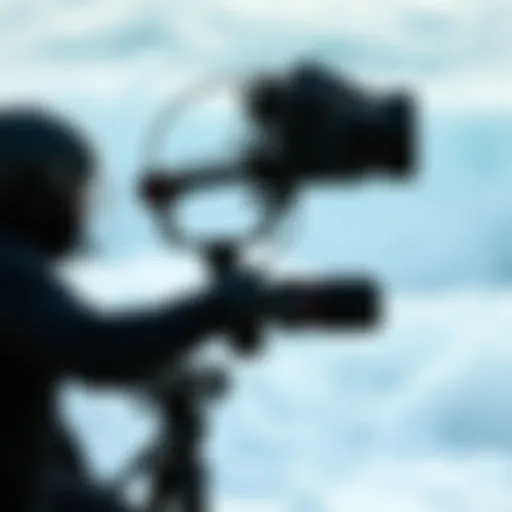Kiteboard Training: Techniques and Best Practices


Intro
Kiteboarding is not just a sport; it's a dance with the wind and water, an art that demands both finesse and courage. For many, the thrill of gliding over waves, coupled with the adrenaline rush of jumping into the air, creates an almost magnetic pull towards this sport. This comprehensive guide aims to untangle the various threads of kiteboard training, weaving together essential techniques, gear advice, and training locations to elevate your experience on the water.
Whether you're just dipping your toes into kiteboarding or you're a seasoned rider looking to perfect those advanced tricks, there's knowledge here for all. Let's set sail on this journey, exploring the building blocks of kiteboarding and ensuring that safety and skill development take center stage as we navigate the vast ocean of information ahead.
Techniques for Kiteboarding Enthusiasts
Beginner Techniques
For those new to kiteboarding, starting with the basics is crucial. Understanding the essentials can make or break your initial experience.
- Learning to Fly the Kite: A common misstep is jumping right onto the board without first mastering kite control. Spend time on the beach flying the kite, practicing steering and control. Understanding how the kite reacts to the wind is key.
- Body Dragging: Once you're comfortable with the kite, the next step is body dragging. This technique teaches you how to move through the water while still attached to the kite. It's an important skill for retrieving your board if you fall off.
- Getting Up on the Board: After feeling confident with body dragging, it's time to get up on the board. Remember, keep your knees slightly bent, look ahead instead of down, and use the power of the kite to lift you out of the water.
Advanced Maneuvers
Once you've nailed the basics, the thrill of advanced tricks is just around the corner. These maneuvers require a mix of confidence, skill, and practice.
- Jumping Techniques: A good jump starts with the right board speed and kite position. Keep your knees bent as you edge hard against the kite to generate lift. Timing is everything; pull on the back hand just before take-off.
- Tricks like Backrolls and Frontrolls: As you become more comfortable in the air, consider adding flips to your repertoire. For backrolls, initiate the trick with your head looking over your shoulder while pulling on the back hand. For frontrolls, look forward and never forget to keep your body streamlined.
"With every jump, you not only rise higher but also push your limits—kitesurfing is as much about conquering fears as it is about mastering skills."
Equipment Reviews
Kite Reviews
Choosing the right kite is fundamental for successful kiteboarding. Different kites are designed for different styles and conditions. Here’s a quick rundown:
- C-Kites: Known for their performance in the air, C-kites are excellent for advanced tricks and powerful jumps.
- Bow Kites: With a greater range of depower, bow kites are great for beginners as they make it easier to control power on the water.
- Hybrid Kites: A blend of the above, hybrid kites cater to a variety of riding styles and are a good all-round option.
Board Reviews
Just like kites, selecting a suitable board can change your kiteboarding experience.
- Twin Tip Boards: Most common for beginners and intermediates, they provide stability and allow easy direction changes.
- Directional Boards: These are preferred by those who enjoy wave riding and offer excellent performance in surf conditions.
- Foil Boards: For those looking to explore new waters, foil boards let you glide above the water, offering a unique experience.
Finding the right equipment is crucial to honing your skills effectively. It's like trying to paint a masterpiece; having the right brushes—kites and boards—makes all the difference.
Stay tuned as we delve deeper into training practices, safety measures, and popular training locales where you can further refine your skills in the exhilarating world of kiteboarding.
Understanding Kiteboarding Fundamentals
Kiteboarding sits at the intersection of thrilling water sports and intricate mechanics. Grasping the fundamentals is more than just a good idea; it’s a necessity for anyone hoping to conquer the waves with a kite in tow. This section lays the groundwork, ensuring that both newcomers and experienced riders bolster their knowledge before diving into training.
To cut to the chase, understanding the core elements of kiteboarding not only fosters safety but also enhances performance. Kiteboarding can be as complex as understanding a game of chess, where each move has a consequence. Let’s explore why the foundations matter:
- Safety: A solid grasp of the fundamentals can prevent accidents and injuries from mishaps on the water. Knowing how the kite behaves in different wind conditions is crucial for your well-being.
- Skill Development: Mastering the basics gives you the building blocks to progress through more advanced maneuvers. It’s like learning to walk before you can run.
- Efficiency in Training: When you know the fundamentals, your training sessions become more focused and productive. You waste less time floundering and more time honing your skills.
In the world of kiteboarding, knowledge is absolutely power. It’s essential to understand not just how to fly a kite, but also the wind’s behavior, equipment setup, and body mechanics. This leads us to a closer look at the basic aspects of kiteboarding.
The Basics of Kiteboarding
Kiteboarding is defined by the synergy between the rider and the kite. At its core, it blends elements of surfing, paragliding, and windsurfing into a cohesive sport. Here are some essentials:
- Kite: The heart of kiteboarding. Understanding its size, shape, and purpose is crucial.
- Harness: A tool for connecting you to the kite. It provides support and helps manage the force exerted by the kite.
- Board: Kiteboards vary widely in styles, impacting performance and maneuverability.
The balance of these components is key to executing maneuvers effectively on the water. Want to ride fluidly? You must learn the interplay between the kite’s pull, your movements, and the board’s responsiveness.
Key Terminology in Kiteboarding
Understanding the jargon in kiteboarding can either make you feel part of the crew or lost in translation. Here’s a smattering of essential terms:
- Depower: This refers to reducing the kite’s power to stabilize or slow down.
- Edge: The angle at which the board cuts through the water; it can significantly influence speed and control.
- Upwind: Moving against the wind; it’s vital for positioning yourself against natural currents.
- Loop: A maneuver where you steer the kite in a circle, which can generate power or create impressive jumps.
Knowing these terms not only aids communication but also deepens your understanding, helping you connect with instructors and fellow kiteboarders alike. Plus, it adds a level of confidence when discussing techniques or experiences.
"In every sport, much of success is derived from understanding the language."
A firm grip on the fundamentals and the associated terminology sets the stage for a rewarding kiteboarding journey. As you venture further into this guide, remember that this foundational knowledge is your launchpad for both safety and skill.
The Role of a Kiteboard Trainer
The role of a kiteboard trainer is pivotal in shaping both the skills and the confidence of aspiring kiteboarders. A trainer serves not merely as an instructor but as a mentor, guide, and safety officer rolled into one. The importance of having a skilled trainer cannot be overstated; it can often be the difference between experiencing the thrill of kiteboarding and feeling overwhelmed in the process. With the sport evolving and attracting more enthusiasts, the need for qualified trainers becomes even more paramount. Their expertise helps in laying a solid foundation that ensures safety, builds essential skills, and nurtures a genuine love for the sport.
A kiteboard trainer's influence extends beyond the practicalities of handling equipment and maneuvers; they introduce students to the intricacies of the sport. This includes understanding weather patterns, equipment selection, and safety protocols—elements that can prevent accidents and enhance the learning experience significantly.
In essence, a trainer prepares learners for both the challenges and the joys that kiteboarding has to offer.
What to Expect from a Trainer

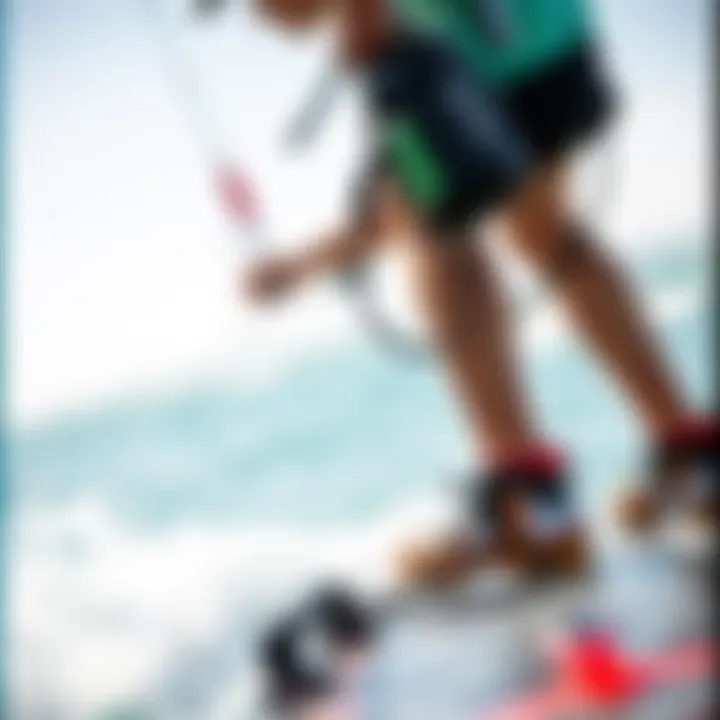
When engaging a kiteboarding trainer, it’s vital to know what to anticipate. A good trainer will present a structured program, starting with the foundational elements of kiteboarding. Here are some key aspects of what one can expect:
- Structured Lessons: Your trainer will lay out a clear lesson plan, gradually increasing the complexity of skills as you progress.
- Hands-On Guidance: Expect direct supervision and feedback during practices. Trainers will demonstrate techniques, allowing you to emulate and learn effectively.
- Safety Briefings: Safety is paramount in any sport. Trainers will begin each session with a thorough risk assessment and discuss safety measures that are crucial for your wellbeing.
- Goal Setting: A good trainer will help you define clear and achievable goals. This will not only motivate you but also provide a roadmap for your learning journey.
- Personalized Feedback: Each student is different; trainers will tailor their coaching to match your skill level and learning pace.
Through these expectations, you can establish a productive relationship with your trainer that encourages improvement and enjoyment.
Qualifications and Skills to Look For
Selecting the right trainer is a significant decision that can impact your entire learning journey. Here are some qualifications and skills that you should prioritize:
- Certification: Look for trainers who have recognized certifications from organizations like the International Kiteboarding Organization (IKO) or other relevant associations. This ensures they possess the necessary skills to teach and ensure safety.
- Experience: Engaging with a trainer who has substantial experience, preferably in various conditions and with different skill levels, can provide valuable insights.
- Strong Communication Skills: Effective communication is key. A trainer must be able to convey instructions clearly and encourage an open dialogue for questions and concerns.
- Technical Knowledge: A good trainer should have a deep understanding of kite design, environmental influences, and equipment maintenance, enhancing the learning experience.
- First Aid Proficiency: It's prudent to ensure that your trainer is trained in first aid, preparing them to handle emergencies if they arise during training.
In poking at these qualifications, you pave the way for a well-rounded learning experience that meets your needs while emphasizing safety and skill acquisition.
Training Techniques for Beginners
Diving into the world of kiteboarding can feel a tad daunting for beginners. Yet, the right training techniques pave the path not only to mastering the sport but also to ensuring safety. These initial strategies set the tone for future development, building confidence and skill incrementally. Understanding the nuances of kite control, safety protocols, and the overall riding dynamics is essential. Therefore, creating a structured learning environment with clear objectives plays a substantial role in progress and enjoyment.
Initial Lessons: Starting Safely
Safety should always be at the forefront of any kiteboarding endeavor. When embarking on your kiteboarding journey, initial lessons are crucial in establishing sound safety practices. This is where you'll learn fundamental skills that will help you understand how to manage your potential risks while on the water.
- Overview of Safety: Your first lesson should incorporate a thorough introduction to equipment. This includes helmet, life jacket, and the control bar, which are pivotal in keeping you safe. Being informed about each piece will help reduce anxiety and encourage sharper skills.
- Safety Protocols: Equipping yourself with knowledge about emergency signals, the buddy system, and understanding local regulations contributes to a safer experience. Consider this the first brick in building your kiteboarding foundation.
"The best safety device is a well-prepared mind."
Focusing on these aspects during the initial stages can make a world of difference as you progress.
Practicing Basics: Kite Control and Trimming
Having safely laid the groundwork, it's now time to harness the power of the kite itself. Kite control and trimming are essential skills that every kiteboarder must nail down before hitting the waves.
- Kite Control Techniques: Control is all about precision and responsiveness to the wind. Starting with exercises on the beach, you’ll learn how to steer the kite through its window, making small adjustments to master its behavior in various wind conditions. Think of this as learning how to dance with the kite, where your movements dictate the flow.
- Trimming the Kite: Trimming isn’t just a fancy term; it refers to adjusting the kite for optimal performance. This involves adjusting the lines to change how the kite reacts in different situations. A well-trimmed kite performs better and gives you a better grasp of control, allowing for smoother rides.
As you practice, remember, it's not just enough to control the kite; you need to build a connection with it—feeling the winds and reading the movements as if they were natural extensions of your body.
First Steps: Riding on Water
Once kite control is second nature, the next step involves finally strapping on that board and getting your feet wet, so to speak. Riding on water is perhaps the most exhilarating phase of the learning journey.
- Getting Started: As you prepare for your inaugural ride, acknowledge that it’s perfectly normal to face struggles. You’ll begin by practicing the water start, which requires you to merge kite control with board balance. Initiating your ride demands a synchronized effort that might take some time to grasp, so patience is key here.
- Body Positioning: Your stance on the board is crucial. Keeping your knees bent and your core engaged will provide both stability and ease of movement. Learning how to fall properly is just as important; this entails letting go of the kite and rolling away from it to prevent injury.
Through repetition and guided practice, you'll gradually progress from stumbling along the water's surface to gliding with confidence.
As you delve into these techniques, you build the fundamental skills that serve as building blocks for your further adventures in kiteboarding. It's these concepts and practices that will shape your journey, illuminating the thrills however choppy the waves may be.
Advanced Training Techniques
Advanced training techniques in kiteboarding serve as the bridge between basic maneuvers and expert-level skills. As riders progress, building on the foundational knowledge becomes crucial for enhancing performance and confidence. The objective is to refine techniques that not only enhance enjoyment of the sport but also ensure safety. Riders who dedicate time to mastering these skills benefit from increased control, better response to various water conditions, and the ability to perform tricks that were once unattainable.
Building on Fundamentals: Transition Skills
Transition skills are core to progressing in kiteboarding. They enable riders to shift directions smoothly and maintain momentum while changing from one side of the wind window to the other. This skill is not just about the physical maneuver but also involves understanding the dynamics of wind and water.
To improve transition skills, consider the following:
- Body Positioning: Maintain a centered stance over the board to help control balance during the transition.
- Kite Movement: Pull the kite higher into the power zone to gain speed, and then quickly navigate it across to initiate the turn.
- Edge Control: Use the board’s edge to carve through the water without losing speed.
Practicing these mini-transitions in flat water can aid in developing muscle memory, allowing the rider to adapt quickly in varying conditions. Make it a habit to assess whether the transition was smooth or jerky. This is key for determining whether to adjust techniques for future attempts.
Mastering Jumps and Tricks
Jumping is often seen as the pinnacle of kiteboarding skills. It opens the door to an array of tricks that are not only exhilarating but also help in building confidence. The thrill of leaping into the air while controlling the descent introduces a new level of freedom and creativity in kiteboarding. Furthermore, understanding how to manage kite power during jumps is essential for safety and performance.
To master jumps, it is helpful to focus on:
- Take-off Technique: Timing is everything; spring off the water just as the kite draws upward. This synchronization maximizes lift.
- Flight Control: Keeping the kite steady and maintaining body position during the jump will dictate height and distance.
- Landing Safely: Strive for a soft landing by bending your knees and keeping the kite low to mitigate any impact.
Tricks can range from simple grabs to more complex rotations. A good way to learn new moves is to break them down into smaller components. Start with the take-off, practice the flight, and then add in the landing technique. Above all, record your sessions for constructive feedback. This helps in analyzing what works and what doesn’t, ultimately refining your skills over time.
"Success in kiteboarding lies not just in how high you can jump but in how gracefully you can return to the surface."
Continuing on this journey of advanced training techniques dovetails into creativity and personal style. As skills grow, the focus should shift to expressing individuality through the execution of various tricks, while always prioritizing safety. Remember, the ocean is ever-changing. Being adaptable not only prepares one for every moment on the water but also positions the rider for continual improvement.
Selecting the Right Equipment
When it comes to kiteboarding, the right equipment can make or break your experience on the water. Selecting suitable gear not only enhances your performance but also significantly contributes to your overall safety. As you navigate through the waves, having the appropriate kites and boards tailored to your skill level and conditions is paramount.
It’s easy to feel overwhelmed with the myriad of options available, each professing to be the best on the market. A thoughtful approach to choosing equipment involves understanding your personal needs, evaluating what’s suitable for various conditions, and considering the skill level you’re at. This careful selection allows you to progress effectively and enjoyably in your kiteboarding journey.
Types of Kites: Advantages and Disadvantages
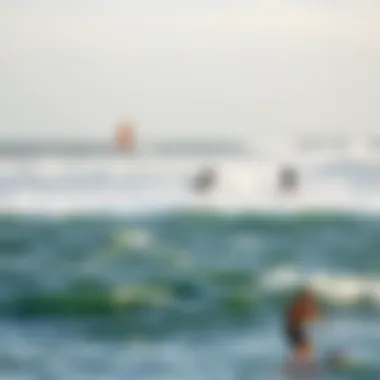
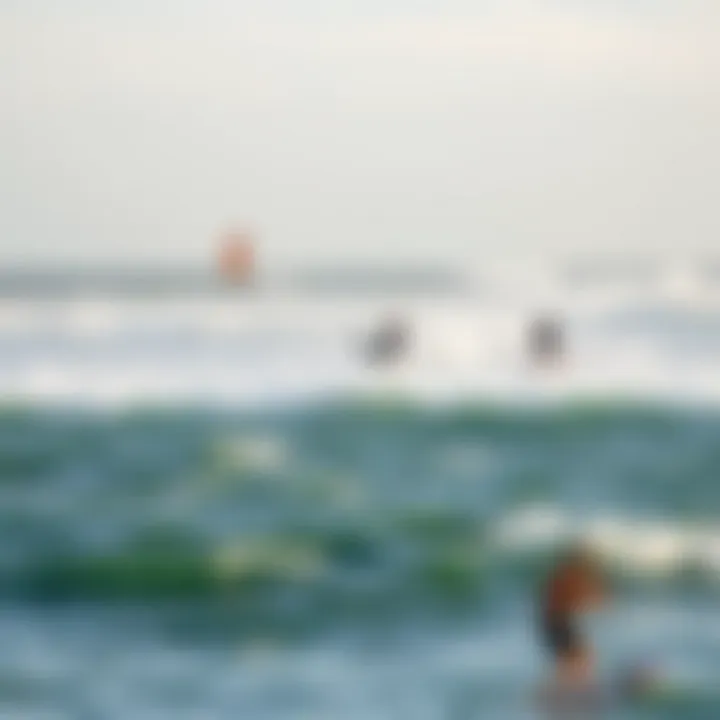
When diving into the world of kiteboarding, kites are undeniably the centerpiece of your gear. There are mainly two types of kites you’ll encounter: inflatable kites and foil kites.
Inflatable Kites
- Advantages:
- Disadvantages:
- Easy to relaunch from the water, perfect for beginners.
- Stable in a range of wind conditions.
- Generally, more durable due to their robust construction.
- Heavier, which can affect maneuverability.
- Requires regular maintenance to check for leaks and damage.
Foil Kites
- Advantages:
- Disadvantages:
- Lighter, making them easier to handle in low winds.
- Excellent for advanced techniques and tricks.
- They pack down smaller, which is ideal for traveling.
- More challenging to relaunch from the water, particularly for beginners.
- Require windy conditions to generate adequate lift.
The choice between these kites will depend on your experience, the wind conditions you'll be facing, and your riding style. Make sure to weigh these factors carefully, as it can significantly affect your enjoyment on the water.
Choosing the Right Board for Your Style
Selecting the right board is another critical component of your kiteboarding setup. There are different types of boards, each designed for specific riding styles and conditions.
A twin-tip board is the most common type for beginners. Its symmetrical design makes it easy to ride in both directions, offering a comfortable experience while you learn. On the other hand, directional boards are more suited for wave riding and provide better control in choppy water but require more skill to master.
When picking your board, consider the following:
- Board Size: Larger boards provide more stability and floatation, which is helpful for beginners. In contrast, smaller boards are more responsive and better for tricks.
- Flexibility: A stiffer board is generally better for performance and speed, while a more flexible board offers better control, especially for rough waters.
You should assess your riding style, whether you prefer aggressive tricks, cruising, or exploring in small waves to determine what works best for you.
Essential Safety Gear
Safety should always be your number one priority when kiteboarding. Although kiteboarding is a thrilling sport, it comes with its hazards. Ensuring you have the right safety gear is crucial before heading out on the water.
At a minimum, you should invest in the following:
- Helmet: A comfortable, well-fitted helmet is essential in case of any falls.
- Impact Vest or Buoyancy Aid: This not only provides flotation but further reduces the impact during hard landings.
- Harness: A high-quality harness helps distribute the load while riding, allowing for better control and comfort.
- Safety Leash: Essential for connecting yourself to the kite. It serves as a fail-safe in case of any emergencies, preventing the kite from drifting away.
Always inspect your gear before heading out. A simple check can prevent serious accidents in a high-speed sport like kiteboarding.
Closure
Selecting the right equipment can be seen as building the foundation for your kiteboarding journey. It requires careful consideration and often a bit of trial and error. Balancing your preferences, safety needs, and desired performance can lead to a gratifying kiteboarding experience that not only maximizes your fun but also enhances your skill as you progress.
Safety Practices in Kiteboarding
Safety is paramount in kiteboarding, a sport that, while exhilarating, can pose significant risks without proper precautions. Engaging in kiteboarding training requires not only enthusiasm but also a solid understanding of safety practices that can mitigate risks. These practices serve to protect both the rider and others in the water, ensuring a safer and more enjoyable experience for everyone involved. In this section, we will delve into two critical aspects of kiteboarding safety: understanding weather conditions and implementing safety protocols during training sessions.
Understanding Weather Conditions
Weather conditions play a crucial role in determining the safety and feasibility of kiteboarding activities. Kiteboarders need to be astute observers of the environment, as changing wind patterns, storm systems, and water conditions can significantly impact safety.
Here’s what every kiteboarder should know:
- Wind Speed: Ideal conditions typically range between 10 to 20 knots for most kiteboarding sessions. Winds that are gusty or over 25 knots can be unsafe, especially for beginners. Always check local wind reports and forecasts such as those from NOAA (National Oceanic and Atmospheric Administration) for accurate data.
- Storm Awareness: Thunderstorms can develop quickly. It's advantageous to stay informed about local weather patterns. If cumulus clouds start building up or dark patches appear in the horizon, it may be time to head in.
- Currents and Tides: Understand how tides and currents can affect the water where you practice. Some spots might have strong currents that can quickly pull you away from the designated safe areas.
- Local Knowledge: Engaging with local kiteboarding communities via platforms like Reddit or region-specific Facebook groups can provide valuable insights into particular weather conditions and hazards.
"Knowledge of the weather is a kiteboarder's best friend. It's not just about riding the waves; it's about respecting nature's rules."
Safety Protocols During Training Sessions
Implementing rigorous safety protocols during training sessions is crucial to mitigate risks associated with kiteboarding. Here are important guidelines that should be practiced:
- Pre-Session Briefing: Before hitting the water, all participants should gather for a briefing. Discussing the weather outlook, the training objectives, and emergency procedures creates a common understanding amongst all team members.
- Buddy System: Always train with a partner. Kiteboarding can sometimes bring unexpected issues, and having someone close can be lifesaving. If one person gets into trouble, the other can assist or call for help.
- Safety Gear: Wearing a helmet and impact vest is paramount. These pieces of equipment can protect against injuries from crashes and equipment malfunctions. Not forgetting the use of a quick-release mechanism on the harness is essential for quick detachment from the kite in emergencies.
- Emergency Plan: Define and practice a clear emergency plan. This includes knowing how to signal for help and ensuring that everyone is aware of where to go if conditions deteriorate.
- Post-Session Reflection: After training, take some time to review what went well and what could be improved. This not only promotes safety awareness but also ensures continuous learning regarding safety protocols.
Evaluating Progress: Metrics of Success
When diving into the realm of kiteboarding training, it’s crucial to assess your development along the way. This evaluating progress phase not only helps in recognizing how far you’ve come, but it also illuminates the areas where more focus is needed. It’s like finding your way with a map and compass; without direction, it’s easy to drift off course.
Identifying suitable metrics plays a pivotal role in your training journey. These benchmarks provide tangible evidence of your advancement, ensuring that learning and improvement occur at a steady pace. They serve as a feedback loop, enabling kiteboarders and instructors to adjust techniques and challenges. Not having these metrics can leave learners adrift, unaware of their systemic progress or the practical skills they've developed.
Setting Realistic Goals
Establishing realistic goals is essential in any training regimen, and kiteboarding is no exception. Setting the bar too high can lead to frustration while aiming too low often results in stagnation. A good approach is to use the SMART criteria: goals should be Specific, Measurable, Achievable, Relevant, and Time-bound.
For instance, a beginner might set a goal to be able to ride for a full session without falling, while a more advanced rider might aim to land a particular trick by the end of the season. Some effective strategies include:
- Start with simpler objectives that gradually evolve into more complex skills.
- Write down your goals and keep track of them regularly.
- Celebrate small victories to keep motivation high.

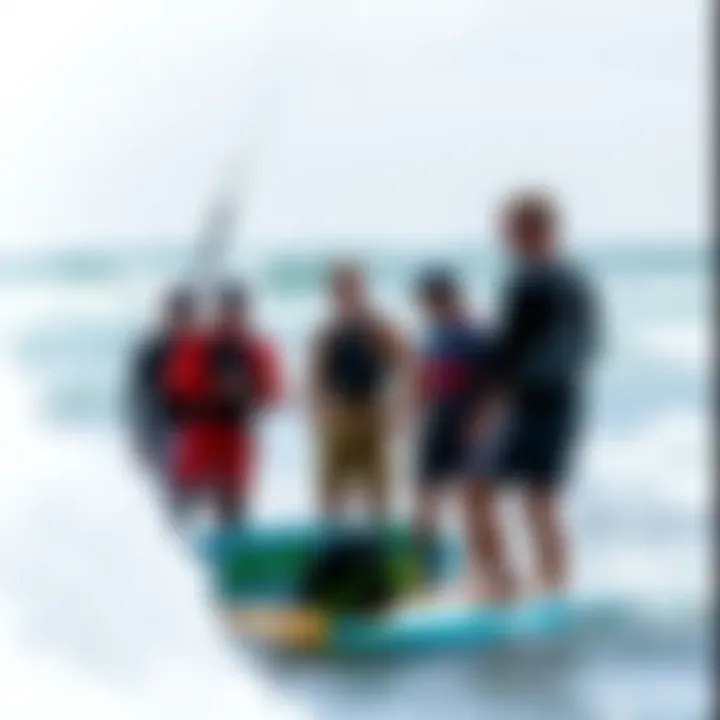
Remember, kiteboarding is about enjoying the ride as much as it is about progress. Having achievable targets can make the learning process both rewarding and enjoyable.
Feedback Mechanisms: Trainer and Self-Evaluation
Feedback is the cornerstone of effective training. It’s twofold—coming from both your trainer and your own self-assessment. While instructors bring a wealth of experience and knowledge, self-evaluation offers a unique perspective, allowing learners to assess their techniques and performance critically.
Trainers provide crucial insights on your technique. They can spot bad habits that may go unnoticed by you, such as incorrect posture or inefficient kite control. Having regular check-ins with your trainer ensures that you’re aligned with your progression.
On the flip side, self-evaluation encourages reflection. After every training session, take a moment to jot down your thoughts. Was there a particular challenge that pushed you? Did you try something new? This practice can reveal patterns over time and help you understand your strengths and weaknesses.
Combining these mechanisms will create a well-rounded training experience, leading to noticeable improvements. Remember this saying: "You can’t improve what you don’t measure." Integrate feedback regularly, and your kiteboarding skills will soar.
"Success is the sum of small efforts, repeated day in and day out." - Robert Collier
Resources for Further Learning
- Wikipedia on Kiteboarding
- Kiteboarding Forums on Reddit
- Kiteboarding Equipment on Amazon
- National Kiteboarding Association
Popular Kiteboarding Training Locations
When diving into the world of kiteboarding, where you choose to train can significantly influence your learning curve and overall experience. The right location offers not just inviting waters and favorable winds, but also a sense of community and opportunities to connect with fellow enthusiasts. Beginners and advanced kiteboarders alike benefit from a well-suited environment that accommodates their skill levels, making the choice of location an essential part of training.
These spots provide not just a playground for practicing skills but also serve as a hub for sharing knowledge, tips, and tricks with others. Furthermore, the beauty of the landscape and presence of local clubs can greatly enhance the training experience, setting the stage for both progression and lasting memories.
Top Global Destinations for Beginners
Every beginner kiteboarder needs a gentle introduction to the sport, and certain locations around the globe stand out as perfect starting points. Here are a few top destinations:
- Tarifa, Spain: Known for its constant winds and shallow waters, Tarifa has earned a reputation as the kiteboarding capital of Europe. Schools here are plentiful, and you'll find a vibrant community eager to offer advice and support.
- Kite Beach, Cape Town, South Africa: This iconic beach is another fantastic spot for novices. The beauty of Table Mountain as your backdrop only adds to the allure. The conditions here are easily manageable for starters, along with numerous instructors ready to help you catch your first wind.
- El Gouna, Egypt: Clear waters and consistent wind conditions make El Gouna an inviting option for beginners. Plus, many schools offer packages that include accommodation, so you can focus solely on learning without the hassle of logistics.
These locations ensure that beginners can practice in a safe and engaging environment, helping them build confidence as they transition into more challenging stages of the sport.
Advanced Spots for Skill Enhancement
As kiteboarders progress, their thirst for new challenges grows. For those ready to refine their skills, certain destinations shine as ideal venues for honing advanced techniques:
- Maui, Hawaii: Well-known for its powerful winds, Maui is a testing ground for those looking to push their limits. The varied conditions across its beaches allow for progressive learning, and it's also a hotspot for watching pros in action.
- Cumbuco, Brazil: With their long beaches and consistent winds, the lagoons of Cumbuco attract kiteboarders from around the world. The area offers various conditions that can challenge your skills, from flat water to fun waves.
- Hood River, Oregon, USA: Often referred to as the mecca for kiteboarding in the U.S., Hood River has it all—steady winds, diverse water conditions, and an active kitboarding scene. This location is perfect for those looking to learn exciting tricks and transitions.
These advanced spots not only provide the right conditions for skill enhancement but also offer the possibility to network with experienced kiteboarders, fostering an environment where learning happens collectively.
"Choosing the right training location is crucial—it’s more than just a space to ride. It’s about community, safety, and the chance to learn from others."
Each of these locations has its perks, tailored to different skill levels, ensuring that every kiteboarder finds their perfect fit. Whether you aim to take your first glide or polish complex tricks, there’s a place out there that will meet your needs.
Community Resources and Networking
Engaging with community resources and networking opportunities is pivotal in the world of kiteboarding. Building connections within this vibrant community can significantly enhance one’s learning experience and foster a sense of belonging. Kiteboarding may be an individual sport, but it thrives on the ties formed between enthusiasts, trainers, and local clubs. This section delves into the advantages of leveraging local and online resources and highlights the benefits of active community participation.
Online Forums and Social Media Groups
In today’s digital age, information is just a click away. Online forums and social media groups serve as valuable platforms for kiteboarding enthusiasts of all levels. Here, kiteboarders can share their experiences, ask for advice, and keep up with the latest trends in the sport. Some notable platforms include:
- Reddit: Subreddits dedicated to kiteboarding, such as r/Kiteboarding, are treasure troves of information. Users often engage in discussions about gear, locations, and personal experiences, providing a space for novice and veteran kiteboarders alike to interact.
- Facebook Groups: Communities such as "Kiteboarding Community" or localized groups for specific regions foster communication between members. These groups set the stage for sharing ideas and offering support.
- Specialized Websites: Sites like KiteForum.com allow users to post questions, share tips, and connect with fellow kiteboarders around the globe. It’s an ideal place to tap into collective knowledge and find inspiration for rides and new techniques.
Participating actively in these platforms can help smooth out the bumps along the road of learning. One can ask questions and receive pragmatic responses from others who have been in similar situations. Ultimately, these virtual interactions can cultivate friendships and partnerships that extend to the water.
Local Kiteboarding Clubs and Events
Getting involved in local kiteboarding clubs and events is another way to tap into community resources. These clubs not only facilitate organized training sessions but also host social gatherings, races, and workshops that promote skill enhancement and camaraderie.
Benefits of joining a kiteboarding club include:
- Peer Support: Being surrounded by fellow kiteboarders creates a learning environment where members can support each other. Insight from more experienced kiteboarders can drastically shorten the learning curve for newcomers.
- Organized Events: Clubs often host events that include skills workshops, competitions, or social events like meet-ups on the beach. This opens avenues for fun and the chance to practice under various conditions.
- Access to Equipment: Some clubs offer rental gear or equipment during training sessions. This can be particularly helpful for beginners who are still deciding what type of gear suits them best.
- Safety and Guidance: Clubs often emphasize safety, ensuring that members follow proper protocols and understand the risks involved in kiteboarding. This is crucial, especially for new riders who may not be aware of all potential hazards.
The Future of Kiteboarding Training
The landscape of kiteboarding training is constantly shifting, fueled by innovations that redefine how enthusiasts engage with the sport. This section delves into the pivotal aspects shaping the future of kiteboard training. Understanding these trends can enhance your skills and safety while fostering a deeper connection to the sport.
Emerging Technologies in Training
In recent years, technology has revolutionized how we approach kiteboarding training. One remarkable trend is the integration of virtual reality simulations. By using VR headsets, aspiring kiteboarders can immerse themselves in lifelike scenarios that provide a safe and controlled environment for practicing maneuvers and enhancing overall technique. It's like having the ocean at your fingertips, with no risk of falling into chilly waters.
Drones have also found their place in training. They offer aerial perspectives, enabling both students and instructors to assess performance from new angles. By recording sessions, it becomes much simpler to pinpoint specific areas of improvement. This immediate feedback loop contributes to rapid learning.
Additionally, apps and software tools are making a splash in gear selection and performance tracking. Tools like Windy or KiteMate help monitor wind conditions and suggest optimal locations for riding. These resources ensure that kiteboarders can plan their sessions effectively, maximizing both safety and enjoyment.
"Adapting to new technology isn't just a trend; it's an evolution in how we learn to kiteboard. The goal is to create richer experiences and safer practices."
Influence of Environmental Factors
The environment fundamentally affects kiteboarding, influencing not only safety but training techniques as well. Understanding wind patterns, tide schedules, and local weather forecasts empowers kiteboarders to make informed decisions. For instance, a solid grasp of meteorological factors can lead to more precise training sessions. Moreover, factors like sea currents can alter your ability to master techniques.
Natural variations in wind strength present both challenges and opportunities. For instance, a gentle breeze might be ideal for beginners learning the ropes, while more experienced riders may hone their skills during stronger gusts. Adapting to these shifts is crucial; kiteboarders must develop the ability to read the wind just as closely as they would read the waves.
Climate change raises another consideration. With shifting weather patterns, long-standing training locales may become less predictable or even unsafe. Staying attuned to these changes allows kiteboarders to dynamically adapt their training regimens and select alternative spots as conditions fluctuate.
As we look ahead, the fusion of technology and an awareness of our environmental conditions will undoubtedly play a crucial role in enhancing kiteboarding training methods. Understanding these elements can lead to more tailored training experiences conducive to better performance and enjoyment in the water.















